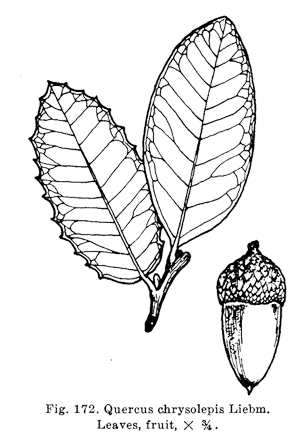Quercus chrysolepis
 canyon live oak, gold cup oak
canyon live oak, gold cup oak

This widely distributed oak is native to the immediate area of campus, including Jasper Ridge Biological Preserve. Being evergreen, it is likely to be mistaken for the common coast live oak (Q. agrifolia), but the lobeless leaves are distinctly smaller. Some leaves may bear teeth, but on more mature growth the margin may be smooth. Woolly fuzz may be found on young shoots and beneath new leaves and on the attractive cup containing the acorn. The handsome shiny dark brown acorns drop from the tree, leaving the cups behind. The timber is of the highest quality, denser than other oak timber, and in the days of wagons was prized for making whiffletrees. Resemblance of the wood to ivory suited it for inlays. Another common name is maul oak. Specimens over 11 feet in diameter in Angeles and Stanislaus National Forests establish Q. chrysolepis as the largest American oak. Huckleberry oak (Q. vacciniifolia), which often hybridizes with Q. chrysolepis, is a main component of the chaparral at Stanford Sierra Camp on Fallen Leaf Lake; it grows only about 3 feet tall.
Though the attractive acorns of gold cup oak could once be collected in a grove southwest of the intersection of Roth Way and Lomita Drive, the trees were lost during construction of chemistry labs in the area. Magic planted two 1-gallon Q. chrysolepis on the berm of Stanford Stadium in 2003; these have almost certainly not survived.
Illustrations: Jasper Ridge photos.
About this Entry: The main text of this entry is from the book Trees of Stanford and Environs, by Ronald Bracewell, published 2005. John Rawlings subsequently added notes on the lost specimens and Magic plantings.



